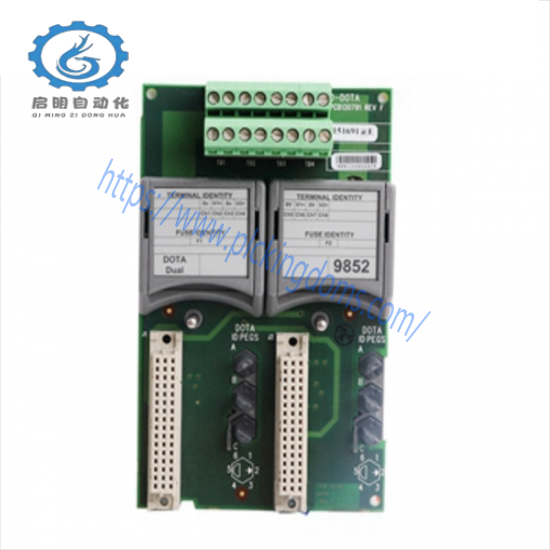1. Unlock the RTC Read variable so it turns FALSE.
2. Select each RTC Program Rack variable and enter the date and time values.
3. Toggle the RTC Write variable TRUE then FALSE to write the new date and time setting to the processor.
4. Lock and force the RTC Read variable to TRUE.
5. The RTC Status rack now displays the new date and time of the processor.
6. Unlock all the RTC Control variables.
Install I/O Modules
Do the following:
• Before inserting a new I/O module, examine it for damage.
• The identification labels on the sides of the I/O module will be hidden when the module is installed. Therefore before installation write down the location of the module and the details shown on the label.
Installation
1. Examine the coding pegs on the termination assembly and make sure that they complement the sockets on the rear of the new I/O module.
2. Place the I/O module on to the dowel pins on the T9300 I/O base unit. Make sure the slot on the head of the module clamp screw is vertical and then push the module home until the module connectors are fully mated with the I/O base unit and termination assembly connectors.
3. The locking screw requires a quarter turn clockwise to lock. Use a broad (9mm) flat blade screwdriver to lock the clamp screw. The locking screw acts as a power interlock device and must be in the locked position when poweris applied otherwise the module will not be configured.
Install T9310 Expansion Cables
Use T9310 expansion cables to connect additional groups of T9300 I/O base units.
The ferrites supplied with the expansion cable are snap on components. Fit the ferrites 50 mm (2 in.) from each end and secure with cable ties either side of the ferrites.
Connect Expansion Cable between T9100 Base Unit and T9300 I/O Base unit (I/O Bus2)
1. Connect the expansion cable to a T9100 processor base unit for an I/O Bus 2 connection.
• Insert a cable socket assembly into the left hand connector of the T9100 processor base unit.
• Secure the socket assembly by inserting the two M3 socket cap screws.
• Tighten the screws with a 2.5 mm Allen key.
• Install the cable to the socket assembly and tighten the retaining screws by hand.
2. Insert the free end of the expansion cable into a right hand socket of a T9300 I/O base unit.
• Insert a cable plug assembly into the right hand socket of the processor or I/O base unit.
• Secure the plug assembly by inserting the two M3 socket cap screws.
• Tighten the screws with a 2.5 mm Allen key.
• Install the cable to the plug assembly and tighten the retaining screws by hand.
1. Connect the expansion cable between a T9100 processor base unit (or a T9300 I/O Base unit) to a T9300 I/O base unit.
• Insert a cable plug assembly into the right hand socket of the processor or I/O base unit.
• Secure the plug assembly by inserting the two M3 socket cap screws.
• Tighten the screws with a 2.5 mm Allen key.
• Install the cable to the plug assembly and tighten the retaining screws by hand.
2. Connect the free end of the expansion cable to the left hand plug of an I/ O base unit using a cable socket assembly.
• Insert a cable socket assembly into the left hand connector of the T9300 processor base unit.
• Secure the socket assembly by inserting the two M3 socket cap screws.
• Tighten the screws with a 2.5 mm Allen key.
• Install the cable to the socket assembly and tighten the retaining screws by hand.
Fault Reporting Reference Information
Each module has a set of front panel status indicators. The function and meaning of these indicators related to each module is as follows:
Status Indicators on the T94xx Series Input and Output Module
Power Distribution and First Power Up
The power distribution and first power up verifies that the power distribution circuits function as designed and as detailed in the drawings. It shows the correct voltages are appearing, and only in the correct places. It also provides an opportunity to verify correct operation of any power indicators outside the controller itself.
Do the following:
1. Make sure all modules are removed.
2. Trip all circuit breakers and disengage all power distribution fuses and field fuses.
3. Apply power to the incoming power terminals.
4. It is good practice to switch on power supplies to field devices before supplies to the controller. Devise a formal sequence in which to switch on individual circuits.
• In sequence, check each circuit breaker orfuse for zero volts on the destination side, and then close the circuit breaker or fuse and verify that the appropriate voltage appears.
• Check that any associated power indicator is lit.
• As each circuit breaker is tested, leave the breaker in the ‘on’ position so that any unwanted connection between different power circuits can be detected.
5. Trip and re-instate each circuit breakerin turn and verify the correct circuits are isolated and restored. Similarly disengage and replace each fuse and verify the associated circuits.
6. At the same time verify correct operation of any power indicators supplied with the system.
Related product recommendations:
ABB 3HAA001-CE
GE DS3800NTCF1C1C
Bently Nevada 330104-00-18-10-02-CN
Allen Bradley 705330-93S
ENTEK E2170/1/80 CORD
RELIANCE 0-51851-6
KEMO 618P-RDB7C
ABB 216NG62A HESG441634R1/K HESG216876
Emerson Ovation 1C31166G01 & 1C31169G02
Yokogawa ADV151-P50-S2
REXROTH MDD071C-N-040-N2T-095GB0
Rockwell Automation 800H-Y51J800H PB
SIEMENS 6ES5941-7UA12 CPU941
A-B 188-K2D500
A-B 800H-JR2KU7DDKK30mm
TRICONEX TRICON 3805H
GE IC756LDV000J-99
ABB NGPS-11
ABB 3HNE 01841-1 Door
Rockwell Automation 1747-PTA1E
More…




Leave a comment
Your email address will not be published. Required fields are marked *